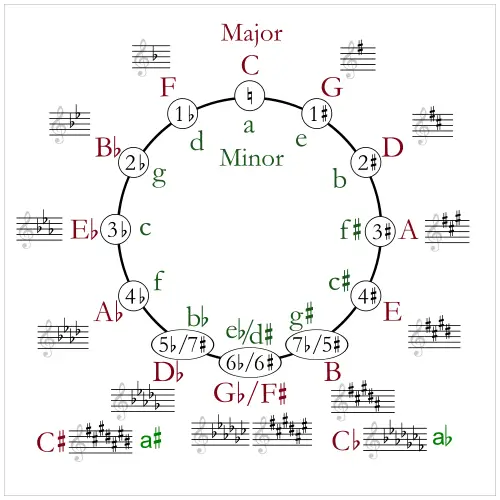- Home
- Basic Piano Theory
- Scale Degree Names
Music Scale Degree Names in Major and Minor Scales
This article may contain compensated links. Please read the disclosure for more info.
Confused about scale degree names?
Here you will learn about the scale degrees in major and minor scales, and exactly why they have those funny names!
Scale Degree Names in Major and Minor
Did you know that each step in both major and minor scales have a specific name?
These names are called scale degree names. Scale degrees are all related to each other, depending on where they are in the scale.

Tonic and Dominant
The first/bottom note of a scale, both in major and minor, is called the Tonic.
Tonic means "tone" and represents the "home" key or tonality. This is the most important note of the scale, and where a melody in this key normally wants to end.
The fifth note of the scale is called the Dominant.
As the name implies, this is a very strong note in the scale, it is the second most important, since it "wants to go back home" to the Tonic, or it leads back to the Tonic.
These two notes, or steps in the scale, the first and the fifth; are the most important steps of the scale:

Subdominant
The next scale degree that is important is on the fourth step, in both major and minor. It is called the Subdominant.
As you perhaps know, sub is Latin for "under"; like sub-way.
So, that the Sub-Dominant is on the step below the Dominant should seem accurate...
But actually- this is not the "sub" it refers to! Read on and later I will explain why.

Supertonic, Mediant and Submediant
But first let's take a look at the rest of the steps in the scale and their specific scale degree names:
- On the second step is the Supertonic. Super sounds great, right? It would sound as it's the most important, but it isn't. Super is Latin for "above" and "beyond". So, the Super-Tonic is above the tonic. OK. Logic.
- On the third step is the Mediant, which is Latin for "to be in the middle". In the middle of what? In the middle of the two most important degrees; the Tonic and the Dominant!

On the sixth step is the Submediant. Now that's annoying, isn't it? Since it is not under the mediant... why is it called Sub-Mediant?
Here is the explanation, as I promised earlier:
The Tonic and the Dominant are so important, that they almost don't allow any other players. Here is how:
The distance from a Tonic to a Dominant is a perfect fifth, upwards. But, if we instead go downwards a perfect fifth from the Tonic, that is actually another Dominant- but it is called a Subdominant, because it is....
Under the Dominant!

And that particular note is the on the fourth step of the scale; the Subdominant. So, it's not quite as you thought- right?
Now that we got that out of the way, let's do a somersault with the Mediant as well!
The Mediant is located on the third step of the scale, upwards from the Tonic. If we instead go downwards three steps from the tonic, there is the...
You guessed it! Submediant!

Leading Tone or Subtonic?
That leaves us with only one more scale degree. On the 7th step. This is where it gets interesting, since this is the only scale degree that has different names in major and minor.
In major it is called the Leading tone. Since it is only a semitone away from the Tonic on the 8th step (back home again!), this little interval creates a sound of "wanting to go home...". Hence the name "Leading tone"; it leads back Home.
 Enharmonic pitches
Enharmonic pitchesScale Degree Names in Minor
As we saw above, all scale degree names ar the same in major and minor, except for the 7th step.
In minor we have three alternating scale patterns; the natural, harmonic and melodic minor. In these scales the 6th and 7th steps are changed, like so:
Natural Minor
In natural minor the 7th step is a wholetone away from the Tonic (on the 8th step). This doesn't "lead home" as much as a semitone. So the scale degree name is instead; Subtonic. Yeah- plain and simple under the Tonic.

Harmonic Minor
In harmonic minor the 7th step is a semitone away from the Tonic. So, this is called a Leading tone, as in major.

Melodic Minor
 Melodic minor ascending.
Melodic minor ascending.In melodic minor the 7th is raised when the scale is ascending, so it is also called a Leading tone.
But when descending again, the 7th step is lowered (the same as in the natural minor scale), so then it's called a Subtonic!
I hope this made things clearer! ;)






